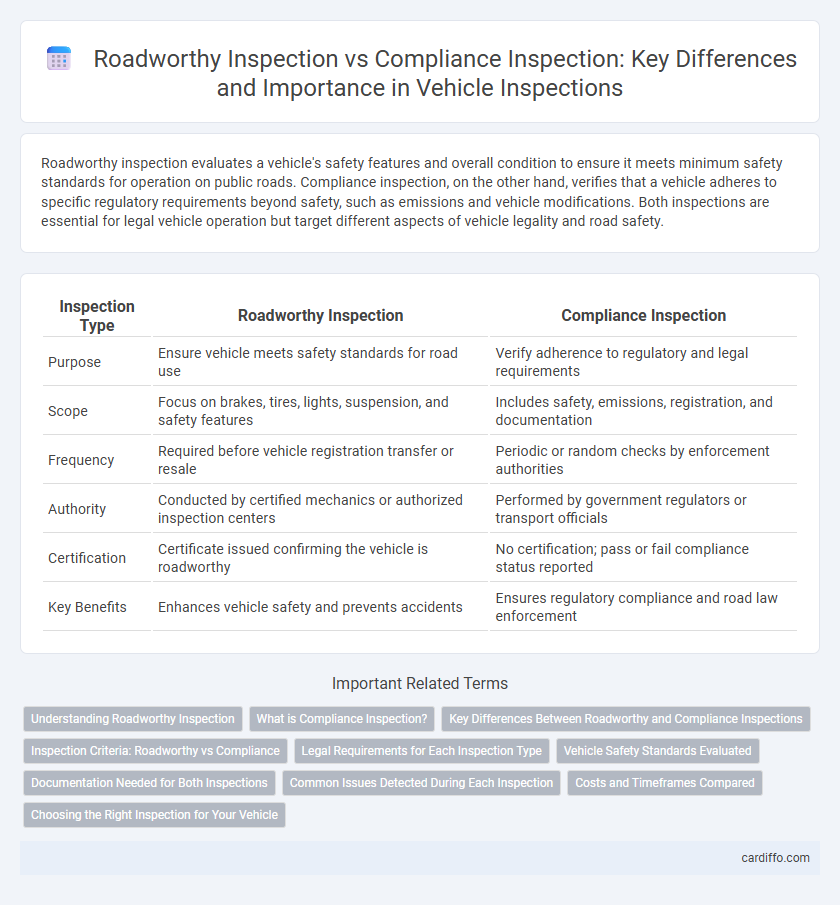Roadworthy inspection evaluates a vehicle's safety features and overall condition to ensure it meets minimum safety standards for operation on public roads. Compliance inspection, on the other hand, verifies that a vehicle adheres to specific regulatory requirements beyond safety, such as emissions and vehicle modifications. Both inspections are essential for legal vehicle operation but target different aspects of vehicle legality and road safety.
Table of Comparison
| Inspection Type | Roadworthy Inspection | Compliance Inspection |
|---|---|---|
| Purpose | Ensure vehicle meets safety standards for road use | Verify adherence to regulatory and legal requirements |
| Scope | Focus on brakes, tires, lights, suspension, and safety features | Includes safety, emissions, registration, and documentation |
| Frequency | Required before vehicle registration transfer or resale | Periodic or random checks by enforcement authorities |
| Authority | Conducted by certified mechanics or authorized inspection centers | Performed by government regulators or transport officials |
| Certification | Certificate issued confirming the vehicle is roadworthy | No certification; pass or fail compliance status reported |
| Key Benefits | Enhances vehicle safety and prevents accidents | Ensures regulatory compliance and road law enforcement |
Understanding Roadworthy Inspection
Roadworthy inspection primarily assesses a vehicle's safety and road readiness by evaluating critical systems such as brakes, tires, lights, and suspension. Compliance inspection, in contrast, focuses on adherence to legal requirements, including emissions standards and registration validity. Understanding roadworthy inspection helps ensure vehicles meet essential safety standards, reducing accident risks and enhancing overall traffic safety.
What is Compliance Inspection?
Compliance inspection is a detailed evaluation ensuring vehicles meet regulatory standards and legally mandated specifications, focusing on safety, emissions, and operational conditions. It verifies adherence to government policies such as emissions limits, equipment requirements, and documentation, crucial for lawful road use. Unlike a roadworthy inspection that assesses overall vehicle condition, compliance inspection specifically targets regulatory conformity and legal compliance.
Key Differences Between Roadworthy and Compliance Inspections
Roadworthy inspections primarily assess a vehicle's safety features to ensure it meets minimum safety standards for legal operation on public roads, focusing on brakes, tires, lights, and structural integrity. Compliance inspections evaluate whether a vehicle adheres to specific regulatory requirements beyond safety, such as emissions standards, load limits, and documentation compliance. The key difference lies in roadworthy inspections targeting operational safety, while compliance inspections encompass broader regulatory adherence including safety, environmental, and legal criteria.
Inspection Criteria: Roadworthy vs Compliance
Roadworthy inspections primarily evaluate a vehicle's safety features, such as brakes, tires, lights, and structural integrity, ensuring it meets the minimum safety standards for operating on public roads. Compliance inspections extend beyond safety checks to include regulatory adherence like emissions testing, registration validity, and specific equipment requirements mandated by local transport authorities. The key difference lies in roadworthy inspections focusing on mechanical and safety criteria, while compliance inspections encompass broader legal and environmental obligations.
Legal Requirements for Each Inspection Type
Roadworthy inspections are legally required to ensure vehicles meet safety standards set by transportation authorities, focusing primarily on brake systems, lights, tires, and structural integrity to confirm the vehicle's fitness for road use. Compliance inspections involve a broader legal scope, including adherence to emissions standards, vehicle registration, and insurance verification, ensuring the vehicle complies with all relevant laws and regulations. Both inspection types are governed by specific legal frameworks, such as the Motor Vehicle Safety Act and state-level transport regulations, mandating distinct documentation and assessment criteria for each.
Vehicle Safety Standards Evaluated
Roadworthy inspections assess a vehicle's fundamental safety features such as brakes, tires, and lights to ensure it meets essential operational standards for safe driving. Compliance inspections evaluate adherence to specific regulations including emission controls, safety equipment, and vehicle modifications beyond basic roadworthiness. Both inspections target vehicle safety standards but differ in scope, with roadworthy focusing on immediate safety readiness and compliance covering regulatory conformity.
Documentation Needed for Both Inspections
Roadworthy inspections require documents such as a valid vehicle registration, proof of insurance, and identification to verify legal ownership and operating status. Compliance inspections demand detailed maintenance records, emission test certificates, and safety feature certifications to ensure the vehicle meets regulatory standards. Both inspections necessitate accurate documentation to validate vehicle condition and regulatory adherence, with roadworthy inspections emphasizing current legality and compliance inspections focusing on safety and emissions compliance.
Common Issues Detected During Each Inspection
Roadworthy inspections commonly detect issues such as worn brake pads, faulty lighting, and damaged tires, which directly impact vehicle safety. Compliance inspections often reveal problems like expired registration, missing insurance documentation, and non-compliance with emission standards. Both inspections play critical roles in ensuring vehicles meet safety regulations, but roadworthy inspections focus on mechanical safety, while compliance inspections emphasize legal and paperwork requirements.
Costs and Timeframes Compared
Roadworthy inspections typically involve a comprehensive assessment to ensure a vehicle meets safety standards, often resulting in higher costs and longer timeframes due to detailed checks. Compliance inspections focus on verifying adherence to specific regulatory requirements, usually resulting in lower costs and quicker completion times. Choosing between the two depends on the vehicle's condition and regulatory needs, with roadworthy inspections demanding more extensive resources.
Choosing the Right Inspection for Your Vehicle
Selecting the appropriate inspection for your vehicle hinges on its intended use and regulatory requirements, with roadworthy inspections primarily assessing safety and mechanical condition to ensure the vehicle meets minimum legal standards for road use. Compliance inspections go beyond safety, verifying that the vehicle adheres to specific regulatory codes, emissions standards, and modifications mandated by authorities or industry standards. Understanding the distinctions between roadworthy and compliance inspections ensures your vehicle remains legally operable and fully compliant with all relevant transport regulations.
Roadworthy inspection vs compliance inspection Infographic

 cardiffo.com
cardiffo.com